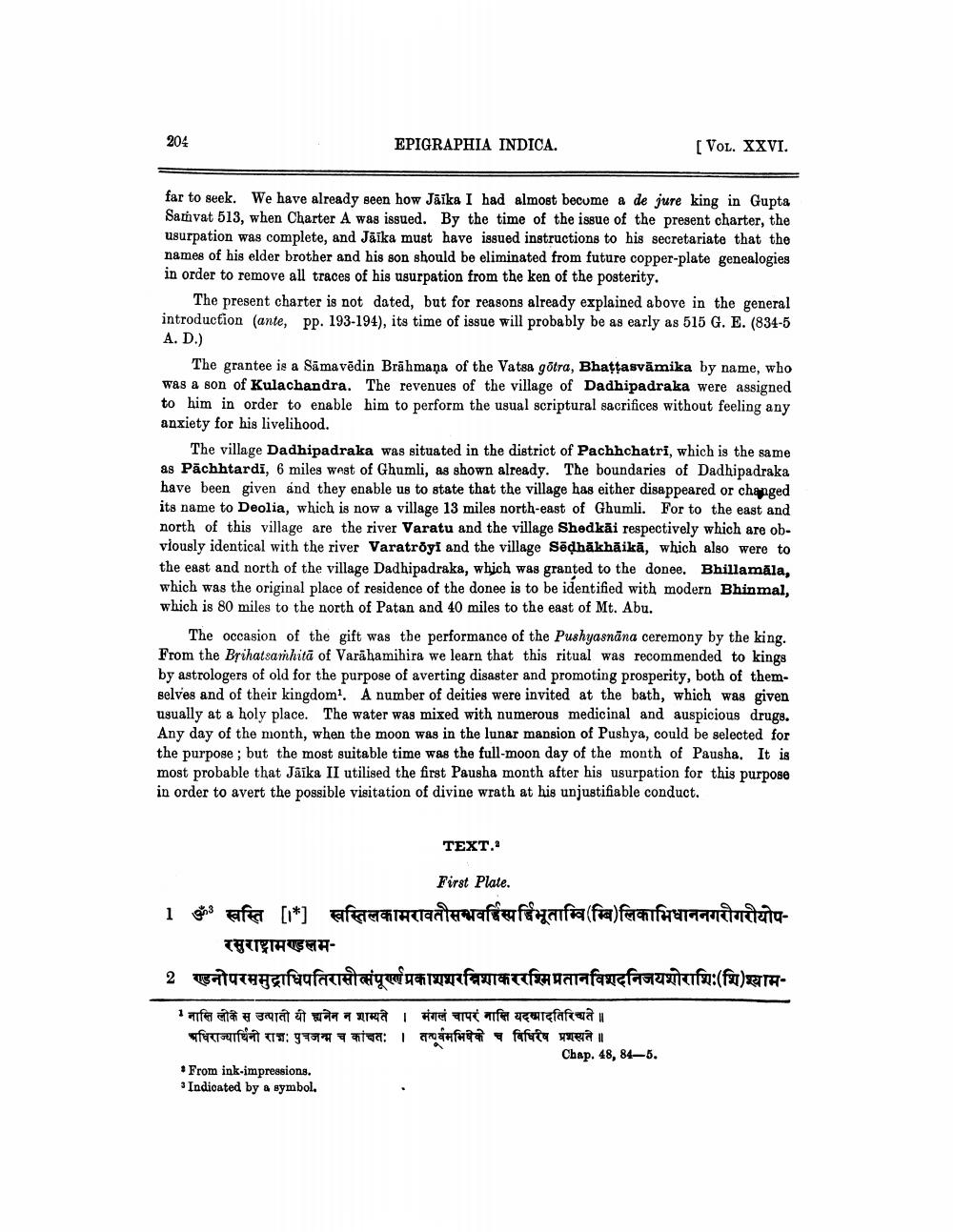________________
204
EPIGRAPHIA INDICA.
far to seek. We have already seen how Jaika I had almost become a de jure king in Gupta Samvat 513, when Charter A was issued. By the time of the issue of the present charter, the usurpation was complete, and Jäika must have issued instructions to his secretariate that the names of his elder brother and his son should be eliminated from future copper-plate genealogies in order to remove all traces of his usurpation from the ken of the posterity.
The present charter is not dated, but for reasons already explained above in the general introduction (ante, pp. 193-194), its time of issue will probably be as early as 515 G. E. (834-5 A. D.)
[VOL. XXVI.
The grantee is a Samavēdin Brāhmaṇa of the Vatsa götra, Bhaṭṭasvamika by name, who was a son of Kulachandra. The revenues of the village of Dadhipadraka were assigned to him in order to enable him to perform the usual scriptural sacrifices without feeling any anxiety for his livelihood.
The village Dadhipadraka was situated in the district of Pachhchatri, which is the same as Pachhtardi, 6 miles west of Ghumli, as shown already. The boundaries of Dadhipadraka have been given and they enable us to state that the village has either disappeared or changed its name to Deolia, which is now a village 13 miles north-east of Ghumli. For to the east and north of this village are the river Varatu and the village Shedkäi respectively which are obviously identical with the river Varatrōyi and the village Seḍhäkhäikä, which also were to the east and north of the village Dadhipadraka, which was granted to the donee. Bhillamala, which was the original place of residence of the donee is to be identified with modern Bhinmal, which is 80 miles to the north of Patan and 40 miles to the east of Mt. Abu.
The occasion of the gift was the performance of the Pushyasnana ceremony by the king. From the Brihatsamhita of Varahamihira we learn that this ritual was recommended to kings by astrologers of old for the purpose of averting disaster and promoting prosperity, both of themselves and of their kingdom1. A number of deities were invited at the bath, which was given usually at a holy place. The water was mixed with numerous medicinal and auspicious drugs. Any day of the month, when the moon was in the lunar mansion of Pushya, could be selected for the purpose; but the most suitable time was the full-moon day of the month of Pausha. It is most probable that Jaīka II utilised the first Pausha month after his usurpation for this purpose in order to avert the possible visitation of divine wrath at his unjustifiable conduct.
From ink-impressions. Indicated by a symbol.
TEXT."
First Plate.
1 ॐ स्वस्ति [1*] स्वस्तिलकामरावतोसम्भवर्द्धिस्पर्द्धिभूताम्वि (म्बि)लिकाभिधाननगरीगरीयोप
रसुराष्ट्रामण्डलम
2 ण्डनोपरममुद्राधिपतिरासीत्संपूर्ण प्रकाशशर विशाक र रश्मि प्रतान विशदनिजयशोराशिः (शि) श्याम
* नास्ति लोके स उत्पाती यी ह्यनेन न शाम्यते । मंगलं चापरं नास्ति यदम्मादतिरिच्यते ॥
अधिराज्यार्थिनो राज्ञः पुत्रजन्म च कांचतः । तत्पूर्वमभिषेके च विधिरेष प्रशस्यते ॥
Chap. 48, 84-5.




